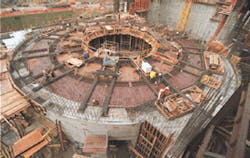Criticism of the National Ignition Facility (NIF), common in recent months, reached an even higher pitch in January, when a federal advisory panel issued a detailed report blasting both NIF management and its overseers. Because of the project's management problems, the panel suggested that the US Department of Energy (DoE) should delay its completion by five years, that is, to 2008, to allow more time for interim tests at Lawrence Livermore National Laboratory (LLNL; Livermore, CA). The panel also said that the project's cost will increase, although it did not provide a specific estimate of the extra expenses beyond the original $1.2 billion estimated budget.
The NIF is to consist of an array of 192 lasers, which would be focused on a pellet of frozen hydrogen. The beams would place the pellet under enormous pressure and heat, triggering thermonuclear reactions. The Clinton administration has touted NIF as the centerpiece of its program to keep the nation's stockpile of nuclear weapons working without resorting to underground nuclear explosions. Data from experiments with NIF are supposed to help refine computer simulations that would replace the nuclear tests.
Panel criticizes approach
But the LLNL has encountered major problems with NIF. Last fall, officials notified the DoE that NIF was behind schedule and $350 million over budget. A review commissioned in late November 1999 by the University of California, which operates LLNL, criticized the laboratory's management. However, the new report from the Secretary of Energy's Advisory Board went much farther, strongly criticizing the DoE and the University of California in addition to LLNL officials.
The panel was headed by John P. McTague, former vice president for technical affairs at Ford Motor Company. The report, released in January, pulls no punches: "No one gets a passing grade on NIF management—not the DoE Office of Defense Programs, not Lawrence Livermore National Laboratory, and not the University of California."
The McTague panel said that the NIF budget will have to be increased, though it did not provide a specific figure. For one thing, the panel found that the project's budget is too low because it planned for cost overruns of only 15%. "Such a contingency may be appropriate for an apartment building, but it is not appropriate for a technologically intensive project such as NIF." Instead, the DoE should boost NIF's contingency budget to a level of 30% to 35%, the report says.
The committee also recommended that LLNL not try to use all 192 of NIF's beams at the start. Rather, they endorsed the idea of activating only half the beams for initial testing of the facility, with the second 96 beams to be activated by 2008.
LLNL, the University of California, and the DoE haven't commented on the details of the report. C. Bruce Tarter, director of LLNL, issued a statement saying, "Because it is an interim report, it would be premature to comment on the specific recommendations." Tarter also pointed to the report's conclusion that there are "no technical or managerial obstacles" to completing NIF. "We remain committed to building a strong project-management team and implementing appropriate corrective actions to get NIF back on track."
But the McTague report argues that Tarter isn't giving NIF the attention that it needs from him. Given the project's cost and its importance to the laboratory, the head of the laser project should be elevated to the rank of an associate director of the laboratory, said the report. "The lab director needs to take visible and unambiguous 'ownership' of the NIF project," said the panel, going so far as to suggest that the university base its evaluation of Tarter's job performance heavily on NIF's success or failure.
"The NIF laser system is the largest and most complex optical system ever designed and constructed"; it has 7500 large optical elements, 1600 mirrors, and 2500 lenses (see photo). But the laboratory's approach to NIF—conducting research and development even as design and construction proceeded—was misguided, the McTague committee concluded. "Recent data and experience along with analysis of related engineering experience have demonstrated that the assembly and installation of the laser system must be done in a cleaner and a more painstaking and systematic manner than had been originally planned," the report states.
Additional issues
Another issue raised by the McTague committee is whether LLNL has enough technically qualified staff members for NIF. "Accordingly, they plan to bring in industrial contractors for the assembly of the laser housing and the utilities, a very large and complicated job," says the report. But that may not be the end of the problems, the report warns. "Overseeing the work of these contractors is, in itself, a difficult task and they would do well to bring in an experienced construction management firm to do the job."
"The change in approach is considered essential for the NIF project to achieve its planned performance level, and the new assembly and installation process is expected to substantially increase the project's overall costs and delay the project's completion," the report states.
